The world we live in was built on horseback. Many people today rarely encounter horses, but this is a recent development. Only a few decades ago domestic horses formed the fabric of societies around the globe. Almost every aspect of daily life was linked to horses in an important way. Mail was delivered by postal riders, people traveled by horse-drawn carriage, merchants used horses to transport goods across continents, farmers cultivated their land with horsepower, and soldiers rode horses into battle.
Scholars have long sought to understand how the unique partnership between humans and horses got its start. Until recently, the conventional wisdom was that horses were gradually domesticated by the Yamnaya people beginning more than 5,000 years ago in the grassy plains of western Asia and that this development allowed these people to populate Eurasia, carrying their early Indo-European language and cultural traditions with them.
Now new kinds of archaeological evidence, in conjunction with interdisciplinary collaborations, are overturning some basic assumptions about when—and why—horses were first domesticated and how rapidly they spread across the globe. These insights dramatically change our understanding of not only horses but also people, who used this important relationship to their advantage in everything from herding to warfare. This revised view of the past also has lessons for us today as we consider the fate of endangered wild horses in the steppes. And it highlights the essential value of Indigenous knowledge in piecing together later chapters of the horse-human story, when domesticated horses moved from Eurasia into the rest of the world.
The genus Equus, which includes horses, asses and zebras, originated around four million years ago in North America. Over the next few million years its members began dispersing across the Beringia land bridge between what is now Russia and Alaska and into Asia, Europe and Africa. Horses are among humanity’s oldest and most prized prey animals. Perhaps the first indisputable evidence for hunting with weapons by early members of the human family comes from horse-rich archaeological sites such as Schöningen in Germany, dating to some 300,000 years ago. The unique lakeshore environment there preserved not only the remains of a band of horses but also the immaculately crafted wood spears that humans used to dispatch them. For millennia wild horses remained a dietary staple for early Homo sapiens living in northern Eurasia. People were keen observers of these animals they depended on for food: horses featured prominently in Ice Age art, including in spectacular images rendered in charcoal on the limestone walls of France’s Chauvet Cave more than 30,000 years ago.
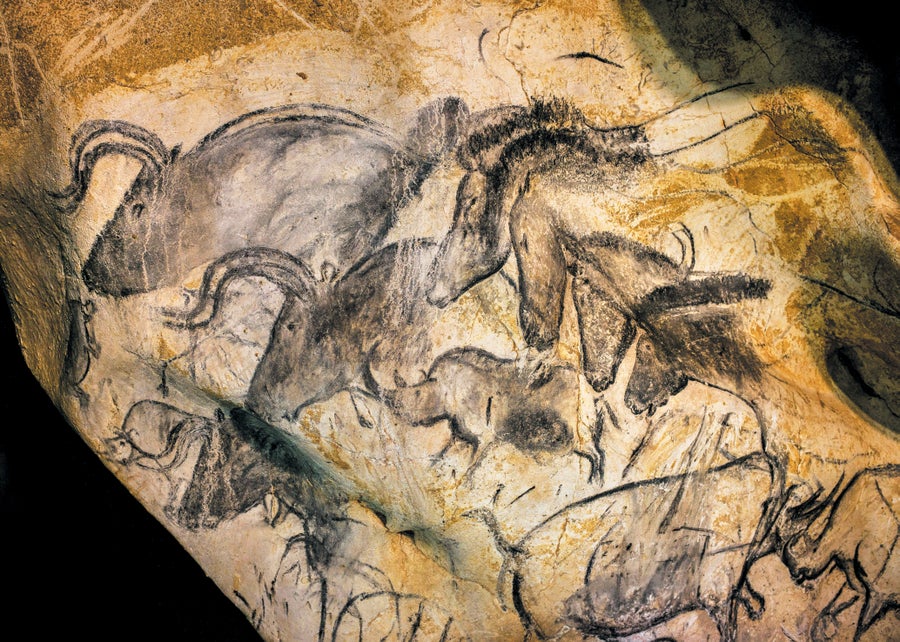
Horses served as muses for Ice Age people, who captured their likenesses in spectacular works of art, such as the images in France’s Chauvet Cave that date to more than 30,000 years ago.
Heritage Images/Getty Images
Tracking the transition from this ancient predator-prey connection to early domestication—which includes such activities as raising, herding, milking and riding horses—can be challenging. Researchers studying the deep past rarely have the luxury of written documents or detailed imagery to chronicle changing relationships between people and animals. This is especially true in the Eurasian steppes—the cold, dry, remote grasslands where scientists suspect that the first horse herders emerged, which stretch from eastern Europe nearly to the Pacific. In the steppes, cultures have long been highly mobile, moving herds to fresh pastures with the changing seasons. Their way of life left behind archaeological assemblages that can be shallow, poorly preserved and difficult to study. Indeed, much of what we know about the origins of horse domestication comes from a single, powerful scientific source: the bones of ancient horses themselves.
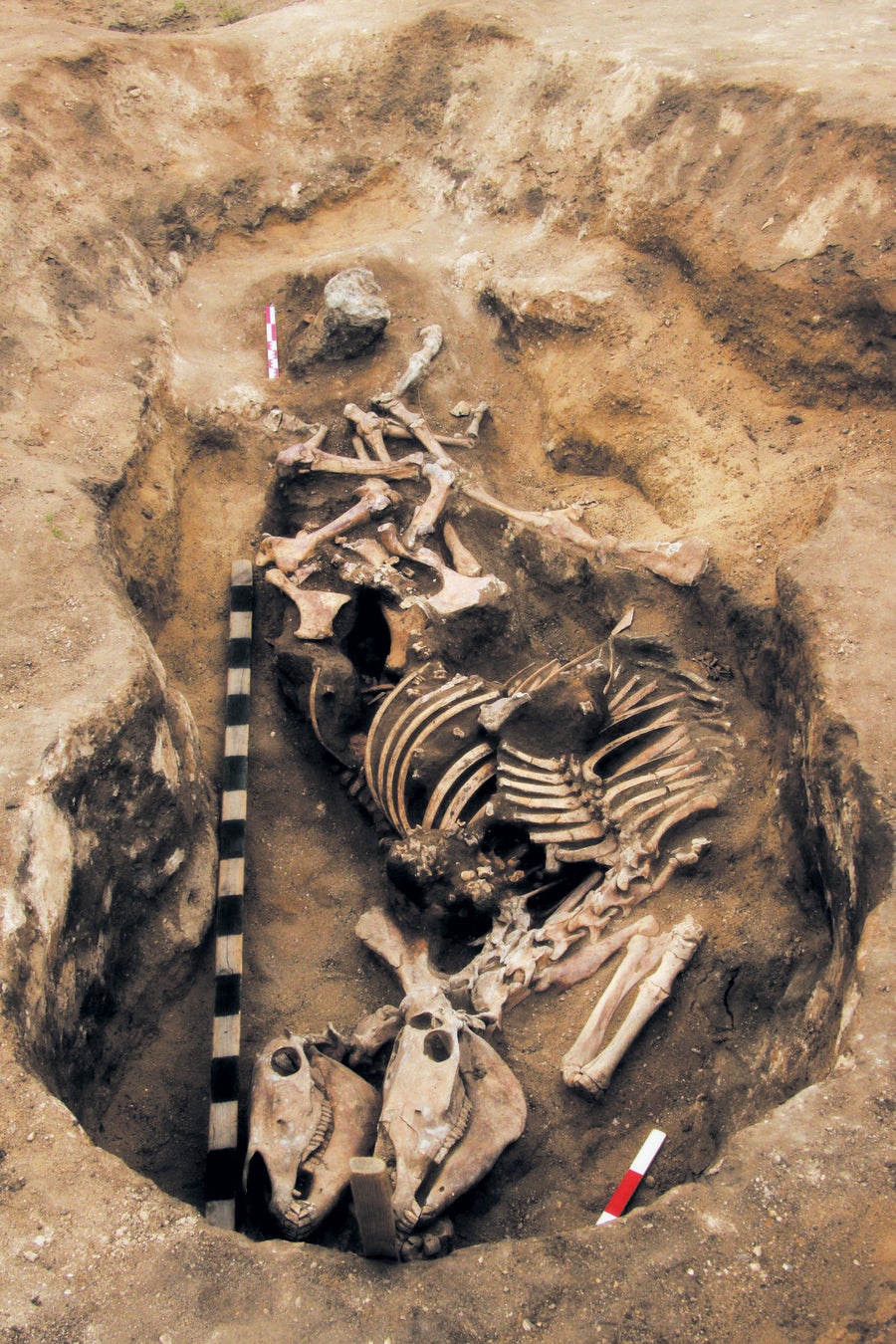
But it wasn’t until much later that people domesticated horses, as evidenced by burials at sites such as Novoil’inovskiy in Kazakhstan dating to the early second millennium B.C.E.*
Emma Usmanova
As an archaeozoologist, I seek to understand the origins of domestication through the study of horse bones from archaeological sites. In the early days of this kind of scientific inquiry into domestication, some researchers looked for patterns in the size, shape or frequency of these bones over time. The basic logic behind this approach is that if horses were living in close contact with people, their bones might have become more widespread or more variable in shape and size than in earlier periods, whether because people were breeding them for particular traits or because they were putting the horses to work in ways that altered the animals’ bodies over the course of their life, among other factors.
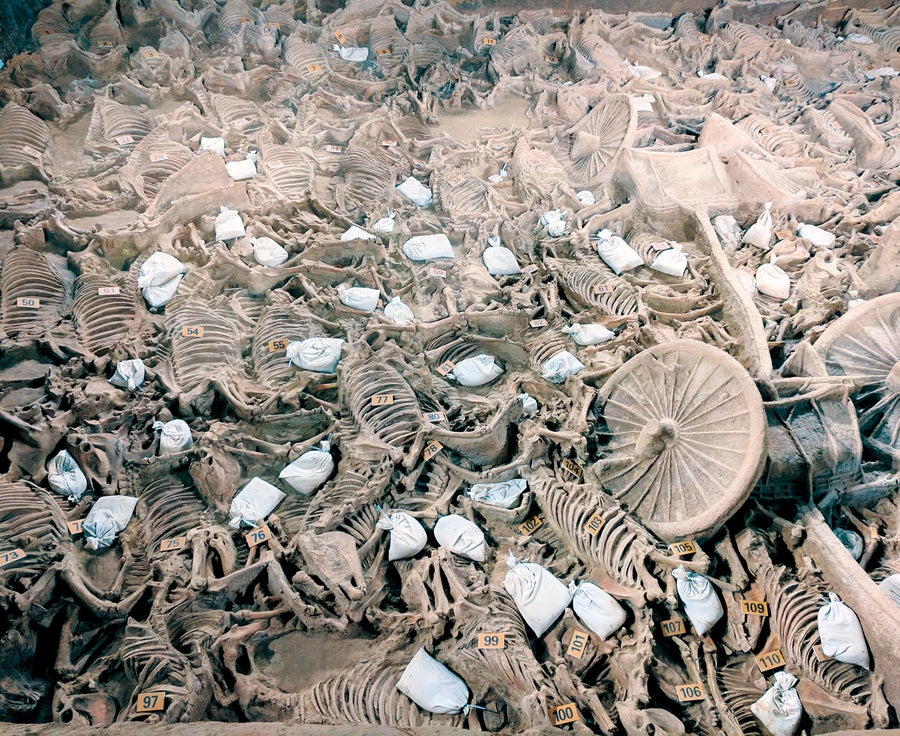
Burials of horses and chariots establish that early domesticated horses were used for transport.
William T. Taylor
But it turns out that looking for these types of patterns in the archaeological record is a little bit like reading tea leaves. Changes in the shape or number of horse bones found at ancient sites could be caused by any number of other things, from environmental change to shifting human diets or even sampling errors. At best, these indicators give us only an indirect way to trace the origin of herding or riding.
A stronger, more scientific understanding of horse domestication began to take shape in the 1990s. Building on the work of some earlier scholars, archaeologist David Anthony of Hartwick College in New York State and his colleagues identified direct evidence for domestication in horse remains, publishing their findings in Scientific American. When horses are used by people for transportation, they sometimes develop a particular pattern of damage on their teeth from the equipment that is used to control them. This damage, known as bit wear, can often be seen on the lower second premolar of horses ridden with metal mouthpieces, or bits. Anthony and his colleagues found bit wear in an ancient horse from a Ukrainian site known as Deriyevka, which was thought to have been home to an archaeological culture known as the Yamnaya people. Although the Deriyevka horse had not been directly dated, its association with the Yamnaya culture suggested that herders in the Eurasian steppes might have been raising and riding domestic horses by the fourth millennium B.C.E. or even earlier.
The Deriyevka horse seemed to tie together a number of loose threads in scientists’ understanding of ancient Eurasia. Beginning after 6,000 years ago, during a period called the Eneolithic (also sometimes known as the Copper Age), large human burial mounds known as kurgans appeared across much of eastern and central Europe and the western steppes. Over the years many archaeologists and scholars hypothesized a connection linking kurgans, the spread of Indo-European languages and the first horse domestication. Specifically, they proposed that the Yamnaya people tamed horses in the Black Sea steppes and then swept across Eurasia on horseback, bringing their burial customs and an early form of Indo-European language—which is believed to have given rise to many languages spoken today, including English. On the heels of Anthony’s discovery, this framework, known as the kurgan hypothesis, gained wide currency in academic literature and popular consciousness.
Unfortunately, the Deriyevka horse was not what it seemed. A decade later direct radiocarbon dating of the remains showed that the animal wasn’t nearly as old as Anthony thought. Instead it had lived and died sometime in the early first millennium B.C.E., when domestic horses and horseback riding were already widespread and well documented. But rather than rejecting the kurgan hypothesis entirely, archaeologists continued to explore other animal-bone assemblages from the western steppes dating to around the same period, searching for horse bones to validate the idea. During this search one site in particular drew renewed interest: Botai, located in northern Kazakhstan.
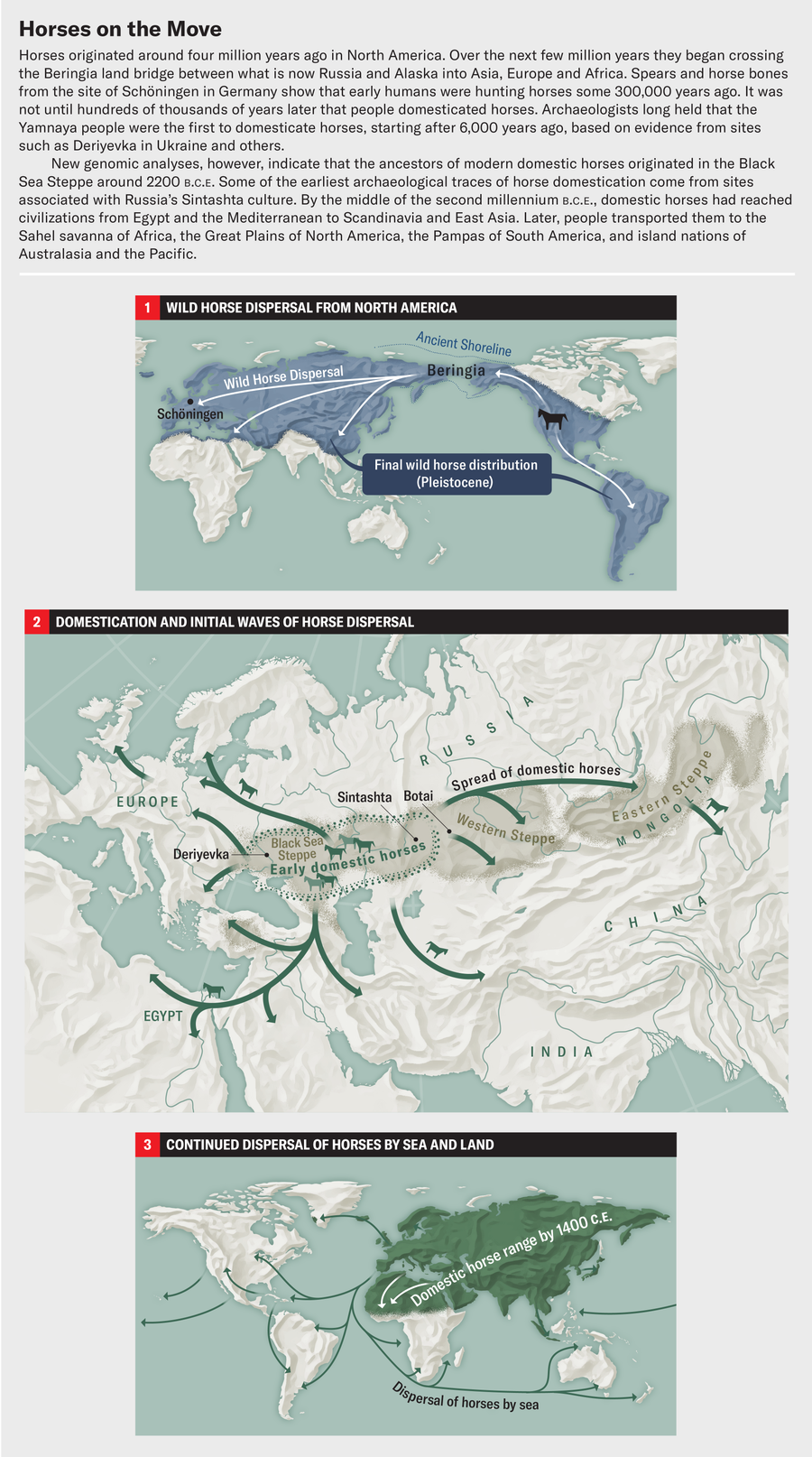
Daniel Huffman
Botai sits some distance east of the Yamnaya homeland. Despite lacking any obvious cultural connections to the Yamnaya, Botai is also located in the western steppes, and like Deriyevka, it dates to the fourth millennium B.C.E. Most interesting, the animal-bone assemblage recovered from excavations at Botai contained huge numbers of horses. In fact, among thousands of animal bones from Botai, almost all were from horses. Working with these materials, archaeologists began to discuss the relevance of Botai’s horses to the question of early domestication.
Early on, the Botai domestication debate was a spicy one. First Anthony and his colleagues suggested that the strange surface shape of some Botai teeth was also a form of bit wear, hinting that the Botai horses were ridden. Soon, though, Sandra Olsen, now at the University of Kansas, identified the same features in wild horses, meaning they could not be taken as proof of domestication on their own. Scholars also looked at contextual aspects of the Botai site, including the architectural layout, speculating that post holes and backfilled pit houses filled with organic material could be leftover traces of corrals and corral cleaning.
Still, other scientists remained skeptical—for good reason. Some Botai horses were found with harpoons directly embedded in their ribs, obviously killed by hunters. An even bigger problem with connecting Botai to domestication, though, was the age and sex patterns among the animals found at the site. In a managed herd of horses, those chosen for slaughter are either very young or very old because breeding-age animals are needed to ensure the herd’s fertility and survival. Marsha Levine and her colleagues pointed out, however, that Botai’s bone assemblage consisted mainly of the remains of mostly healthy adults. Moreover, the site contained large numbers of breeding-age females, as well as some fetal and neonatal horses from pregnant mares. The slaughter of these animals would be devastating to the fertility of a domestic herd, but evidence of it is common in archaeological sites where wild animals were hunted for food.
This healthy disagreement over domestication at Botai was temporarily quashed in 2009, when a high-profile publication in the journal Science brought together new evidence apparently showing that people from Botai milked and rode horses. The authors looked at the shape of the bones of horses at Botai and argued they were similar to the modern domestic horse, Equus caballus. Using emerging techniques for the study of ancient biomolecules, scientists also analyzed ceramic shards from Botai and found residues that seemed to have come from ancient horse fats. These residues, though not diagnostic of milk on their own, had anomalous isotope values, suggesting they could have originated from milk.
The most important new argument, though, was that some Botai horses displayed a different kind of tooth damage that the researchers said could be more securely linked to use of a bridle. With new results from Botai strengthening confidence in the idea of horse domestication during the fourth millennium B.C.E., the kurgan hypothesis returned to paradigm status.
In the decade and a half since Botai revived the kurgan hypothesis, our archaeozoological tool kit for understanding ancient horses has grown by leaps and bounds. And one by one these new techniques and discoveries have begun to erode the connections between Botai and horse domestication. In a recent study, my colleagues and I analyzed dozens of wild horses from Ice Age sites across North America. Our research showed that the key features interpreted as evidence of bridle and bit use at Botai were probably the result of natural variation rather than horse riding or horse equipment.
Moreover, we now know that many other aspects of horse riding can leave a recognizable signature in an animal’s teeth and bones. Halters, saddles and harnesses can make distinctive marks. And different activity patterns, from heavy exertion to confinement, also have identifiable impacts. For instance, the pressure from mounted riding or from pulling a carriage or chariot can each cause unique problems in a horse’s vertebral column or lower limbs. Even early veterinary practices such as dentistry are sometimes visible in the archaeological record. So far none of these more reliable indicators of domestication have been found in Botai horses.
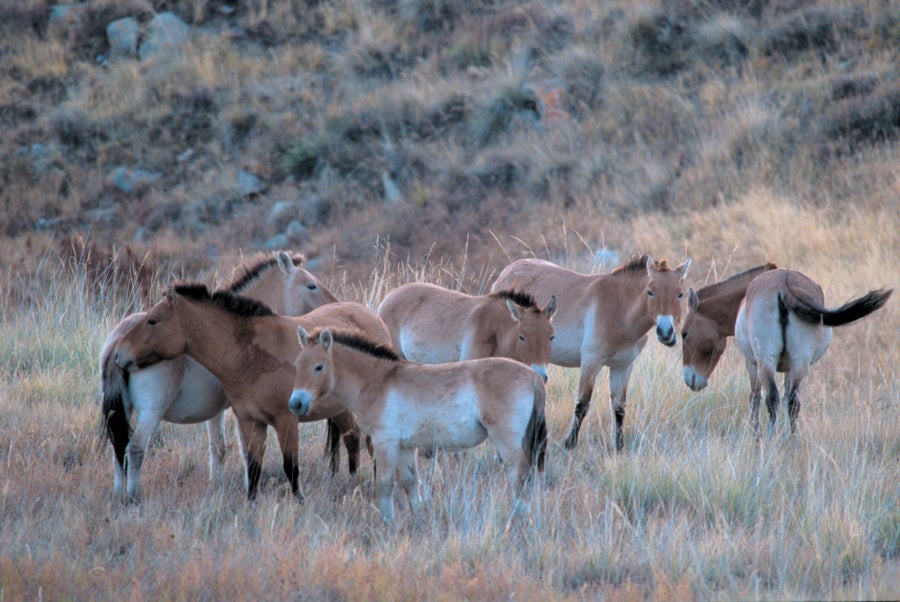
Horses from the site of Botai are now known to have belonged to a wild horse species, Przewalski’s horse, that was hunted for food. Conservation efforts are currently underway to restore this highly endangered species.
Sven Zellner/Agentur Focus/Redux
We can also look to DNA for clues. Improvements in ancient-DNA sequencing now allow scientists to reconstruct partial or whole genomic sequences from archaeological remains. Analysis of DNA from ancient people and animals has yielded some rather remarkable findings, documenting, for example, the migration of Yamnaya people from eastern Europe as far east as Siberia and Mongolia during the late fourth millennium B.C.E. These same techniques have shown no evidence of interaction between Yamnaya people and Botai, however.
Likewise, new techniques for recovering ancient proteins from human dental plaque have shown no evidence of horse milk in the diet of the people who lived at Botai. In fact, horse milk apparently didn’t become widespread in western Asia until the first millennium B.C.E., 3,000 years after the Yamnaya and Botai.
The most devastating blow to the kurgan hypothesis came accidentally from a 2018 genomic study by Charleen Gaunitz of the University of Copenhagen, Ludovic Orlando of the Center of Anthropobiology and Genomics of Toulouse in France and their colleagues that showed Botai horses were not the ancestors of domestic horses at all. Rather they were members of another horse species that still survives today, known as Przewalski’s horse. Przewalski’s horse is a close relative of domestic horses but one that has never been managed as a domestic animal in recorded history.
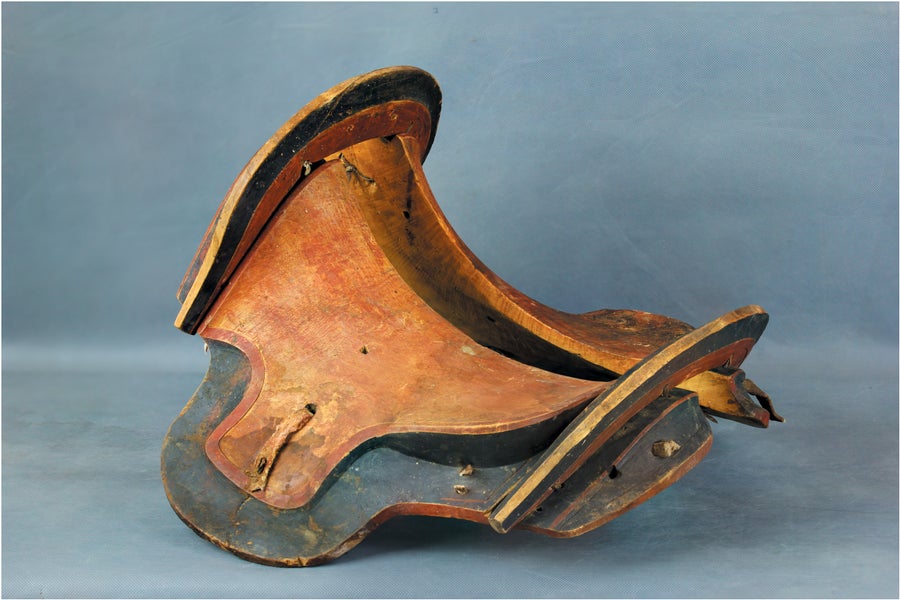
Recent archaeological and genetic insights into horse domestication have relevance for understanding the horse human relationship today. Discoveries of an ancient saddle and other tack in Mongolia show that steppe cultures helped to invent technology that is still in use.
J. Bayarsaikhan
Some scientists remain convinced that Botai has some connection to early domestication but now suggest that the site represents an earlier, failed effort at taming and control of Przewalski’s horse. In their 2018 study, Gaunitz and her colleagues went so far as to argue that modern Przewalski’s horses might be the escaped descendants of domesticated Botai horses, a conclusion that many others in the scientific community felt was unsupported.
The Botai debate has had important real-world impacts for Przewalski’s horse. In the 20th century Przewalski’s horses went extinct in the wild, and zoo populations dwindled almost to the single digits. In recent decades these horses have returned from the brink through a careful captive-breeding program, and they have been reintroduced into some areas of Central Asia. This past June a new band of Przewalski’s horses from the Prague Zoo was released into the grasslands of central Kazakhstan, marking the first return of this species to the region in two centuries.
In the long term, the success and funding of such conservation projects may hinge heavily on public support, making it imperative to get the story straight. Media attention around Botai has sometimes generated headlines suggesting that Przewalski’s horses “aren’t wild after all” and are instead domestic escapees. Narratives like these are no longer supported by the archaeological data and can imperil ongoing protection, conservation and restoration of habitat for this highly endangered species.
Despite some lingering controversy over Botai, the available data emerging from new scientific approaches to studying the past paint a much clearer picture of horse domestication than we’ve ever had before. The recent spate of genomic sequencing and radiocarbon dating of horse bones from across Eurasia has all but disproved the kurgan hypothesis. Such data show us that important cultural developments in the fourth millennium B.C.E.—including the Yamnaya migration and the dissemination of kurgans and Indo-European culture—probably took place many centuries before the first horses were domesticated, aided by the spread of other livestock such as sheep, goats and cattle and the use of cattle to pull wagons. Meanwhile many steppe people still hunted wild horses for meat.
New genomic analyses led by Pablo Librado of the Institute of Evolutionary Biology in Barcelona and Orlando indicate that the ancestors of modern domestic horses originated in the Black Sea steppes around 2200 B.C.E., nearly 2,000 years later than previously thought. Although we do not yet know exactly the details of their initial domestication, it is clear based on the timing that these horses belonged to post-Yamnaya culture. Patterns in the ancient genomes suggest that in the early centuries of domestication, the horse cultures of the western steppe were selectively breeding these animals for traits such as strength and docility.
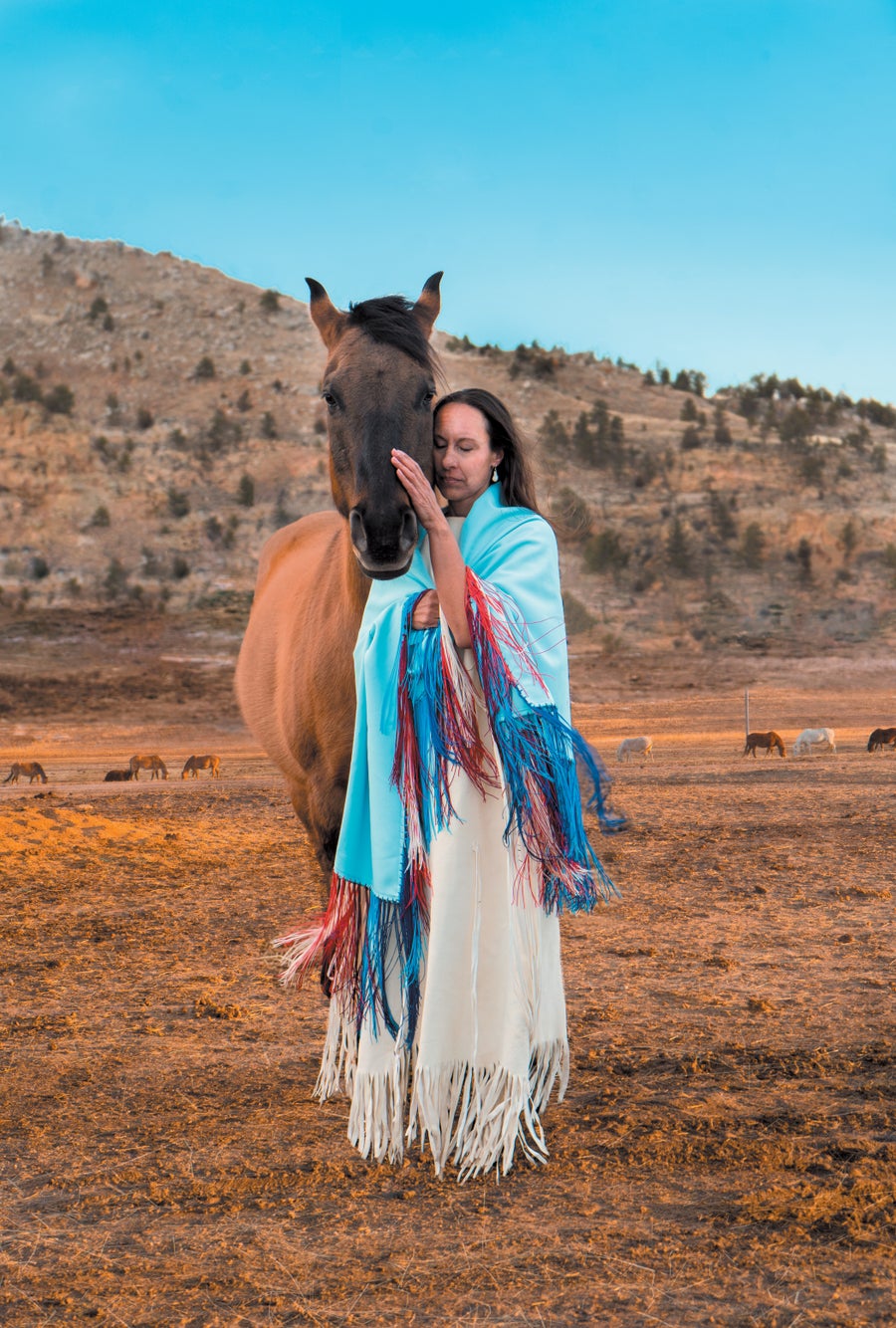
Horses have figured prominently in the traditions and values of the Lakota and many other Native Nations across the Great Plains and Rockies.
Courtesy of the Global Institute for Traditional Sciences
This revised timeline for horse domestication is part of a growing body of evidence that casts the Yamnaya legacy in a new light. Early Indo-European cultures such as the Yamnaya are sometimes portrayed in popular culture in a nationalist manner, with links drawn between their supposed domestication of the horse, impressive transcontinental migrations, and cultural dominance. Now science indicates that the Yamnaya probably didn’t domesticate horses at all, and their migrations were not necessarily heroic conquests. For example, new genomic data show that by around 5,000 years ago Yamnaya migrants reached as far as central Mongolia, where they are known as the Afanasievo culture. Although these migrants may have helped spread sheep, goats and cattle into East Asia, initially it seems their impact was limited to a few mountain regions of the eastern steppe. After the Yamnaya arrival, it would be almost 2,000 years before horses showed up in the region. And genomic analyses suggest that their Afanasievo descendants had little lasting genetic effect on later populations.
The revelation that people domesticated horses much later than previously thought resolves what was always a nagging problem with the kurgan hypothesis. If horses were domesticated in the Eneolithic, why did it take centuries for much of their impact to show up in the archaeological record? Under the kurgan model, researchers often framed horse domestication as a gradual development to explain why it took so long for horses to move beyond the steppes and revolutionize trade and conflicts, for instance. When we look at our records of the past with this revised time frame for horse domestication in mind, there appears to be the rapid, disruptive and dynamic development we expected to see after all.
In our new understanding it seems that almost as soon as people tamed horses, they began using them for transport. Some of the earliest robust archaeological evidence of horse domestication comes from burials of horses paired with chariots dated to around 2000 B.C.E. at sites associated with Russia’s Sintashta culture. Radiocarbon-dating and genetic records show that within only a few centuries domestic horses spread over huge swaths of the Eurasian continent. In some cases, their expansion was peaceful: as availability of horses grew across the steppes, new people incorporated horses, herding and transport into their way of life. In other instances, domesticated horses reached new locales through destructive conquests by marauding charioteers. Some cultures riding this wave of horse-drawn expansion were Indo-European; others weren’t.
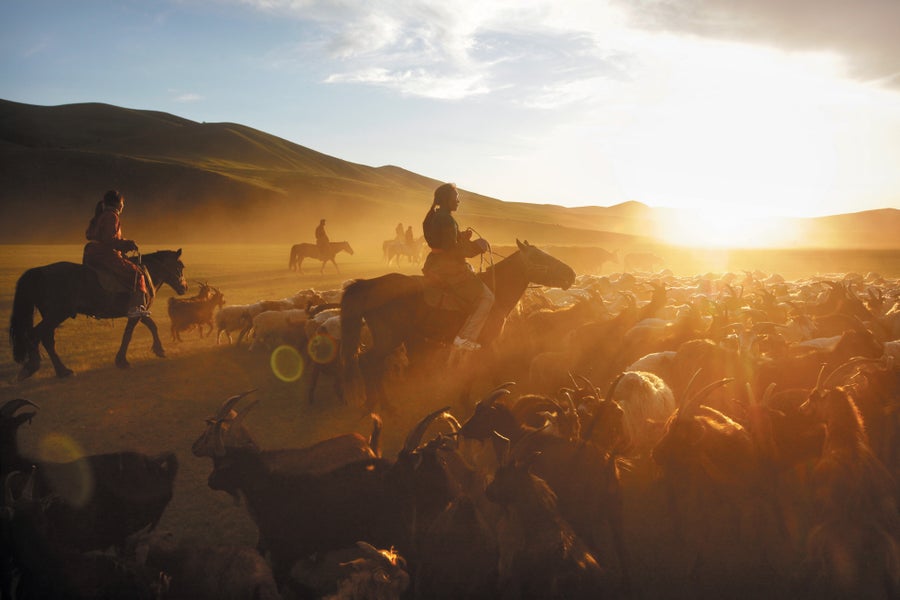
A nomadic family corrals livestock on horseback in Central Mongolia.
Timothy Allen/Getty Images
By the middle of the second millennium B.C.E., horsepower had reached civilizations from Egypt and the Mediterranean to Scandinavia in the north and Mongolia and China in the east. In many cases, the arrival of horses upended the balance of power. For example, when horses first arrived in China during the late Shang dynasty, around 3,200 years ago, they were mostly a novelty for the elite. But within little more than a century a rival power, the Western Zhou, was able to marshal its strength and skill in chariotry to bring a dramatic end to Shang rule. In very short order, horses went from being a steppe curiosity to the foundation of authority for one of the largest civilizations of East Asia.
In addition to clearing up these early chapters of the human-horse story, scientific archaeology has also uncovered connections between the horse cultures of the distant past and our world today. Archaeological discoveries and genomic data from the steppes and deserts of Central Asia are revealing the ways that horses and horseback riding helped humans form networks, trade routes and empires linking the ancient world in new ways.
On horseback, people traveled steppe networks and the Silk Roads to move goods, plants, animals, ideas and even early pandemic diseases across Eurasia and beyond. These emerging transcontinental connections can be directly observed in the archaeological record. In Mongolia, a royal tomb from the early steppe kingdom of the Xiongnu dating to somewhere around 100 B.C.E. was found to contain a silver plate with a picture of the Greek demigod Hercules on it. Historical records document expeditions from China to Central Asia’s Ferghana Valley in search of horses, an early step in the formation of the Silk Roads trade routes, and during the height of the Tang Dynasty, a thriving trade sent horses from the Tibetan Plateau and the Himalaya to lowland China in exchange for tea. Recent DNA sequencing of the plague-causing bacterium Yersinia pestis suggests that the earliest strains of the virus that devastated Europe first emerged deep in deserts, mountains and steppes of Central Asia before spreading along the horse-powered steppe corridors and Silk Roads in the early 14th century.
The corridors and connections that ancient equestrians forged persist today: Ancient travel routes across the Mongolian steppe are now receiving makeovers with Chinese financing to serve as high-speed highways for motor vehicle transit. Even the state highway I take for my daily commute in Boulder, Colo., got its start as a 19th-century postal road.
New archaeology discoveries show that steppe cultures helped to invent or spread important technologies that improved control over horses and are still used today. In Mongolia, my collaborators and I have discovered immaculately preserved ancient tack from some 1,600 years ago. This riding technology, which includes a wood frame saddle and iron stirrups, shows that steppe cultures helped to develop these equestrian devices, which gave riders greater seat stability and the ability to brace or stand in the saddle—significant advantages when it came to mounted warfare. These tools became a standard part of horse equipment in cultures all over the world, from the caliphates of Islam to the Viking explorers of the high Arctic.
Archaeological science also allows us to trace the spread of domesticated horses out of Eurasia as people transported them to such places as the Sahel savanna of Africa, the Great Plains of North America, the Pampas of South America, and even island nations of Australasia and the Pacific, where horses shaped cultures across more recent periods. This work is showing some surprising results.
Recently I worked with a large team of scientists, scholars and Indigenous knowledge keepers to see what archaeology, genomics and Indigenous knowledge systems could tell us about the history of domesticated horses in the U.S. The prevailing view among Western scientists was that Native American peoples did not begin caring for horses until after the Pueblo Revolt of 1680, when Pueblo people in what is now New Mexico overthrew Spanish colonizers. Through our collaboration we found that Native nations from across the Plains and Rockies adopted horses at least a century earlier than was ever chronicled in European historical records. This finding confirms perspectives preserved in some oral traditions and Tribal histories and mirrors our scholarship from similar archaeological contexts in Patagonia.
Many Indigenous horse cultures, for whom a connection with horses is a source of strength, resilience and tradition, are now drawing on collaborative and interdisciplinary archaeological scholarship in their efforts to correct narratives, conserve traditional horse lineages and secure a place for horses in our changing world.
In many ways, the disappearance of horses from daily life in the past century has been as rapid and jarring as their initial domestication 4,000 years ago. In most corners of the world speedy mechanization has replaced trails with pavement and horse transport with engine-powered or electric alternatives. These days, along the Front Range of the Rockies, people wearing jeans and cowboy hats once designed for life in the saddle are more likely to be found shopping at Whole Foods than slinging lassos.
But the threads linking our ever changing present to the distant past are never far if you know where to look. Resolution of some of the most urgent problems of the 21st century—from saving endangered species to conserving cultural knowledge and traditions—will require a clear-headed and scientifically grounded understanding of the millennia-long relationship between human and horse.
*Editor’s Note (11/21/24): This caption was edited after posting to correct the location of the Novoil’inovskiy burial site.